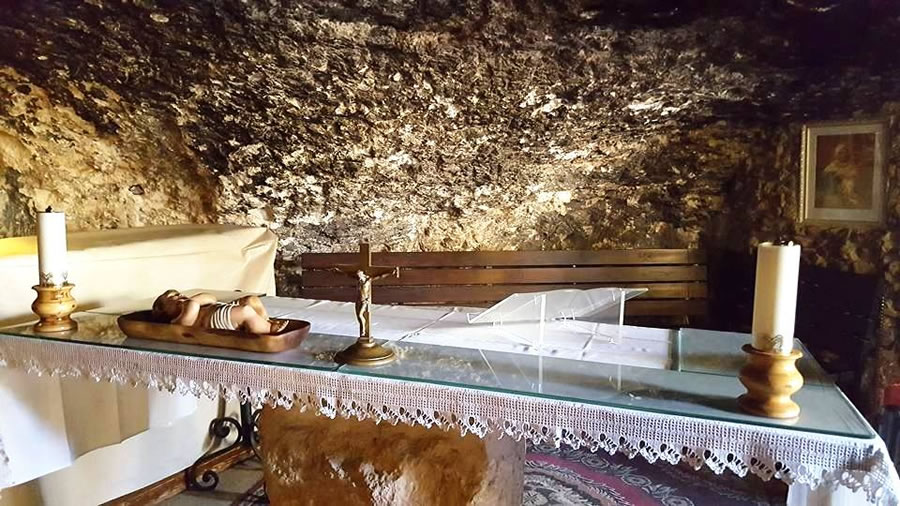
The Gift of the Mass: Reflections On My Pilgrimage to the Holy Land
by Fr. Will Schmid | 12/25/2016 | Weekly ReflectionThis past November I had the pleasure of making a pilgrimage to the Holy Land as a way of celebrating the end of the Year of Mercy. It was a wonderful experience to follow the footsteps of Jesus and to visit the many holy sites of our Lord. As a part of this pilgrimage, I was able to visit and celebrate Mass at many beautiful churches that have been constructed over these holy places. In particular, I was able to celebrate Mass in the Basilica of the Nativity, which is constructed over the cave of our Lord's birth site in Bethlehem. As you can imagine, it was a humbling experience for me as a priest to celebrate the Mass at such a significant place.
However, for many pilgrims who visit the Holy Land each year, the construction of these churches over the various 4 holy sites is confusing. Why were churches constructed over these sites? Why were these sites not preserved in such a way that we could receive a more historically accurate experience of them? Why must massive churches exist above them, obscuring our ability to envision what it looked like at the time of Jesus?
The answer to this question, like many questions, is difficult to obtain. As we already know, the Holy Land has a complicated history, and to fully answer this question, we would need to look at each individual holy site and explain what happened historically Basilica of the Agony in Jerusalem by Shari Stenborg over two millennia. However, I think there is a general theological principle of our Catholic faith that helps us understand the significance of building churches on these holy places. The reason why these sites are holy is because of what our Lord did at these places. As Catholics, we visit them so that we can have a deeper and more profound experience of Jesus. In other words, we visit them with the hope of growing in our faith. For this reason, it makes great sense for us to have churches constructed on these sites, even if they seemingly impede our ability to obtain a sense of historical realism.
As Catholics, we believe that in every celebration of the Eucharist the Paschal Mystery - the life, death, and resurrection of Jesus Christ - is made sacramentally present to us. The Catechism of the Catholic Church says, "Christian liturgy not only recalls the events that saved us but actualizes them, makes them present" (1104). What God desires from us at these holy places is not merely an opportunity to imagine what it was like at the time of Jesus. God also desires that we enter into the perfect worship of His Son at these places so as to have a profound sacramental encounter of Him.
God has done something amazing for us in and through His Son, Jesus Christ. The right response from us in the face of this mystery is to worship Him. This is why at every Mass we respond, "It is right and just," to the priest's invocation, "Let us give thanks to the Lord our God."
The word "Eucharist" in Greek literally means, "to give thanks." There is no greater way for us to thank God than to worship Him in the Eucharist. Since a church is the proper place for the celebration of the Eucharist, and since the most perfect way for us to experience the mystery that occurred at a holy site and thank the Lord for what He did there, it makes perfect sense for a church to be constructed at each holy site.
A pilgrimage to the Holy Land is more than just allowing the Gospel passages to come to life in our minds. It is an opportunity to grow in our faith and to open ourselves up even more to the grace of Jesus Christ. There is no greater channel of God's grace than the Eucharist. There is no greater act of worship we could offer God at these holy places than the sacrifice of the Holy Mass.
As we celebrate the Christmas season, it would be good for us to consider the beauty of the mystery we encounter at every Mass. After all, the breakdown of the word, "Christmas," is "Christ's Mass." The mystery of the birth of Jesus is not separated from us by 5000 miles and 2000 years of history. Rather, through the mystery of the Eucharist, we have an intimate connection with the birth of our Lord.
It is a great privilege to visit the Holy Land, and if you have an opportunity to go, I strongly recommend it. However, if this never becomes an opportunity for you, know that you experience these holy sites in a profound and real way at every Mass. What a fantastic gift!
BACK TO LIST BACK